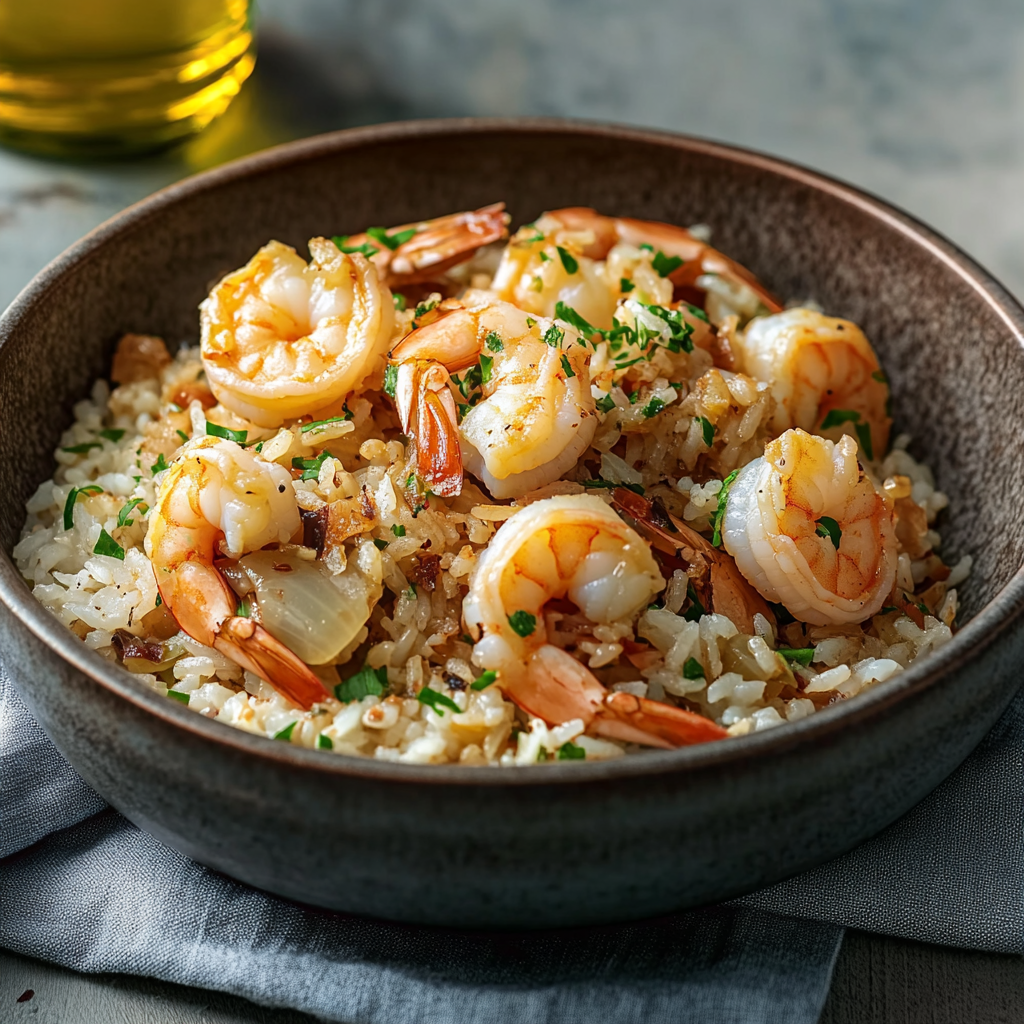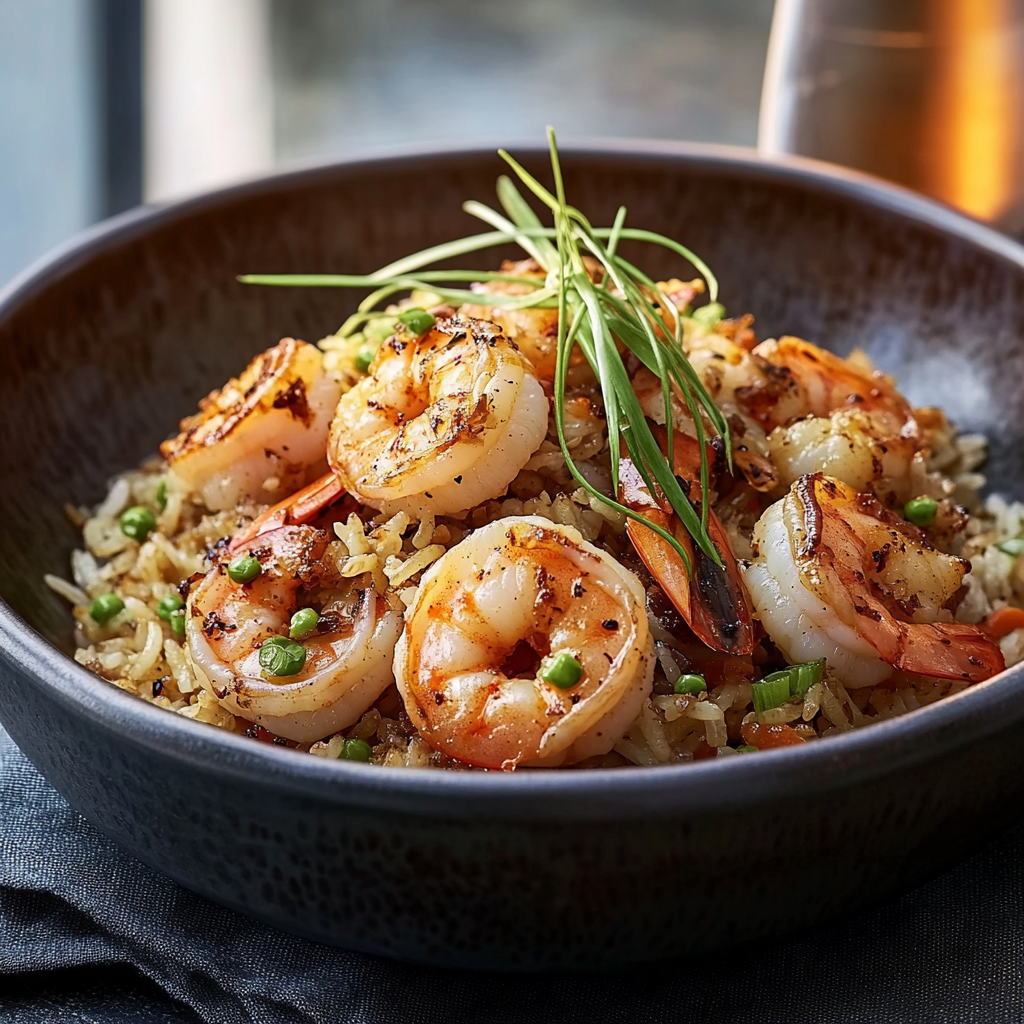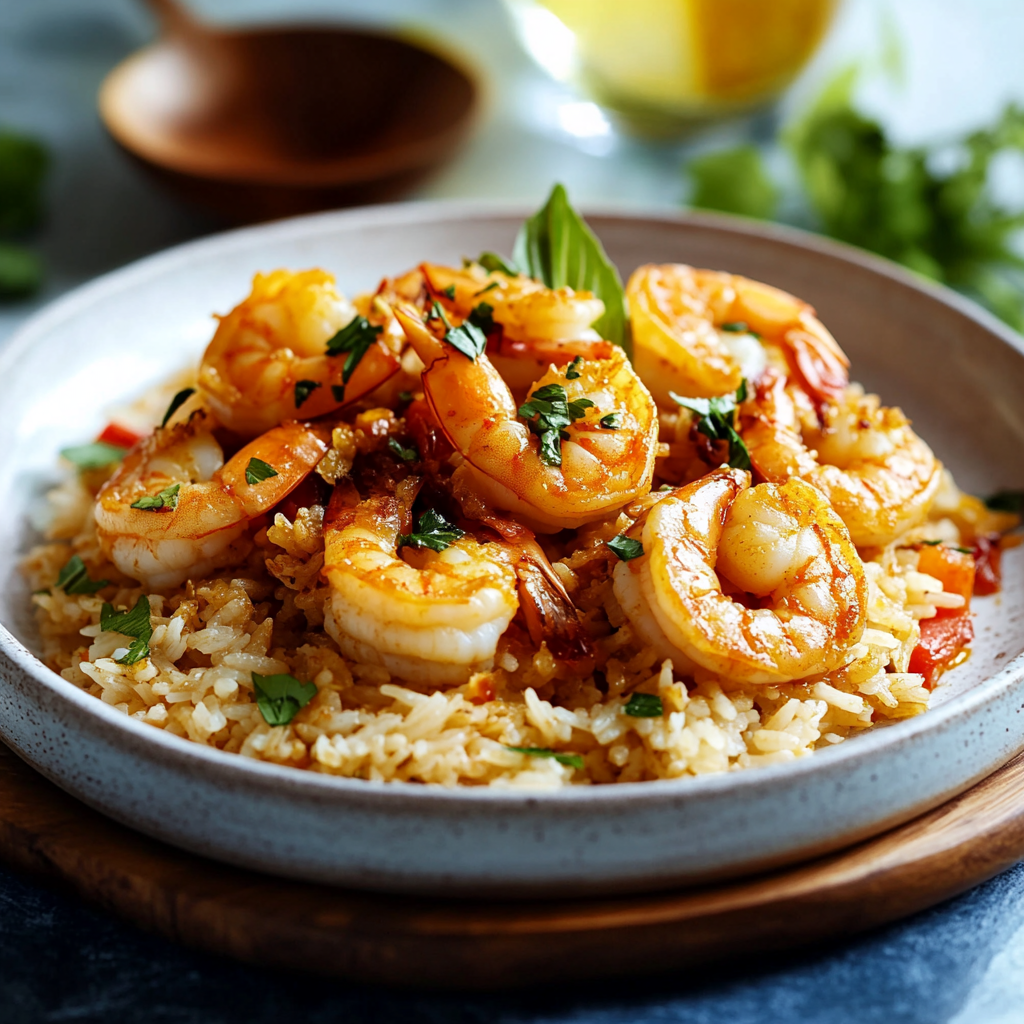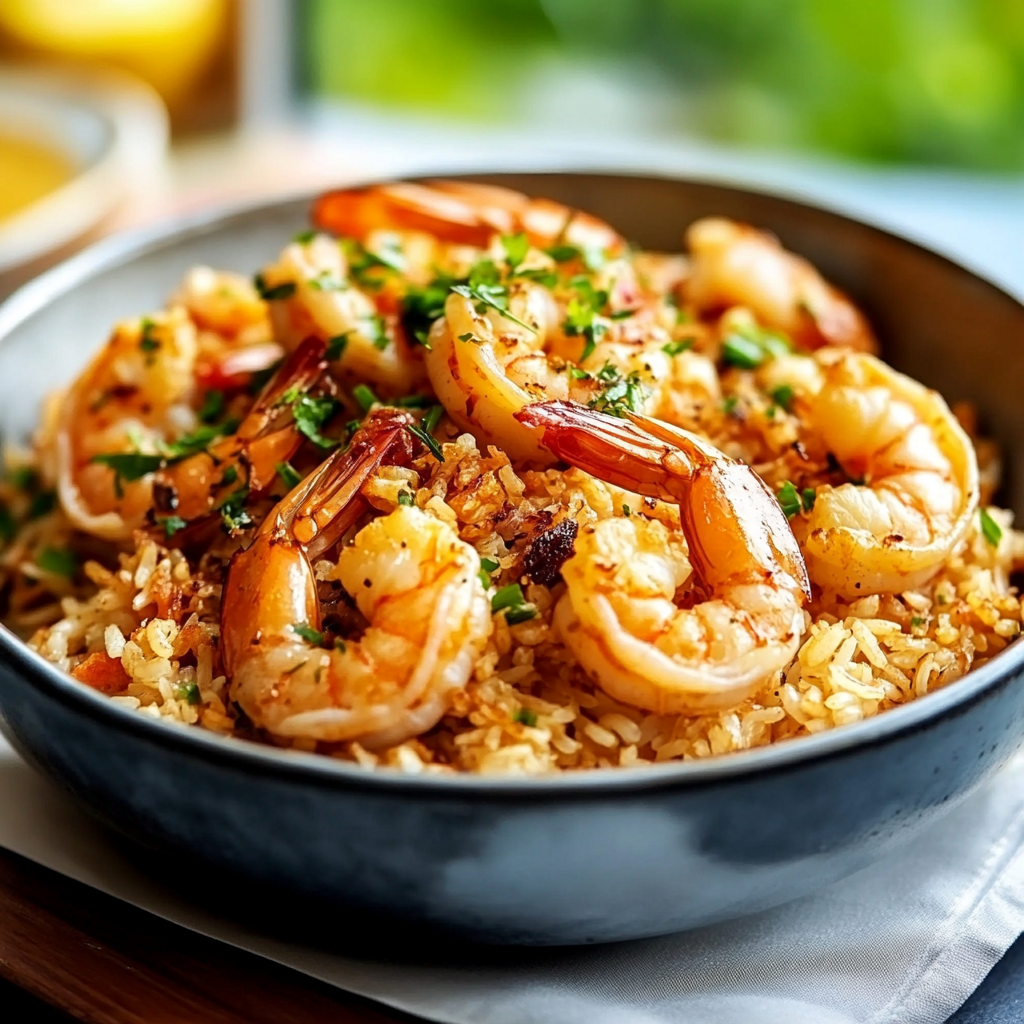Introduction and Quick Summary
If you are on the hunt for a delicious and satisfying meal that combines vibrant flavors and wholesome ingredients, look no further than this Ginger Shrimp with Rice Pilaf recipe. This dish is not only quick and easy to prepare but also provides a delightful blend of textures and tastes that will surely impress your family or guests. The succulent shrimp paired with aromatic rice pilaf creates a comforting yet elegant dining experience. The beauty of this recipe lies in its simplicity; just a handful of fresh ingredients can transform an ordinary dinner into something special.

In this article, we will guide you through the process of making Ginger Shrimp with Rice Pilaf from scratch. You’ll learn about the essential ingredients needed to achieve the perfect balance of flavors. Additionally, our step-by-step instructions will ensure that even novice cooks can create this dish without any hassle. We will also provide tips for serving and storing leftovers so you can enjoy this delightful meal multiple times throughout the week. Get ready to savor a dish that is not only delicious but also packed with nutrition!
Main Ingredients
Shrimp
Shrimp forms the star of this dish. For this recipe, you will need 1 pound of large shrimp, preferably peeled and deveined. Using fresh or high-quality frozen shrimp ensures the best flavor and texture. They cook quickly and absorb the ginger marinade beautifully, resulting in a juicy bite that complements the lightness of the rice pilaf.
Jasmine Rice
For the rice pilaf component, use 1 cup of jasmine rice. This long-grain variety is ideal due to its fragrant aroma and slightly sticky texture when cooked. Jasmine rice pairs wonderfully with Asian-inspired flavors like ginger while providing a soft foundation for the shrimp.
Fresh Ginger
You will need 2 tablespoons of freshly grated ginger for maximum flavor impact. Fresh ginger adds warmth and zest to the dish while infusing it with a lively aroma. Avoid using powdered ginger, as fresh provides a depth of flavor that is hard to replicate.
Garlic
Two cloves of minced garlic will enhance the overall taste profile. Garlic brings an earthy richness that balances well with both the shrimp and the spices in the rice pilaf.
Green Onions
For garnish and added crunch, include 3-4 green onions (also known as scallions). Sliced thinly, they add a pop of color along with a mild onion flavor that brightens up your plate.
Soy Sauce
You’ll need ¼ cup of soy sauce for seasoning the shrimp. This savory ingredient helps deepen the umami flavor while also contributing to the beautiful caramelization during cooking.
Olive Oil
Use 2 tablespoons of olive oil for sautéing both the shrimp and vegetables in this recipe. Olive oil is great for high-heat cooking while adding additional richness to your meal.

How to Prepare Ginger Shrimp with Rice Pilaf
Step One: Marinate the Shrimp
Begin by marinating your shrimp to infuse them with flavor before cooking. In a medium bowl, combine ¼ cup soy sauce, 2 tablespoons freshly grated ginger, and minced garlic from two cloves. Stir until well mixed then add in your peeled and deveined shrimp. Toss gently to coat all pieces evenly in marinade; cover tightly or transfer to a resealable bag if preferred for one hour in the refrigerator. This step allows time for flavors to meld while ensuring your shrimp are tender once cooked.
Step Two: Cook Jasmine Rice
While your shrimp marinates, it is time to prepare your jasmine rice pilaf. Rinse 1 cup jasmine rice under cold water until it runs clear; this removes excess starch which leads to fluffier grains when cooked. In a saucepan over medium heat, warm 2 tablespoons olive oil before adding your rinsed rice along with 1½ cups water or broth (for extra flavor). Bring mixture to boil then reduce heat low enough so it simmers gently while covering tightly—allow cooking undisturbed for about 15-18 minutes until liquid absorbs completely.
Step Three: Sauté Shrimp
Once marinated properly (after at least one hour), heat another tablespoon olive oil in a large skillet over medium-high heat until shimmering but not smoking. Carefully add marinated shrimp (discard leftover marinade) into hot pan ensuring not overcrowd—this may require batches depending on size of skillet used! Cook each side for approximately two minutes until pinkish-orange color appears; avoid overcooking which could lead rubbery texture instead aim crisp yet tender results! Remove cooked shrimp promptly from skillet onto plate once done; let rest briefly while preparing final components.
Step Four: Combine Rice Pilaf With Vegetables
With shrimp resting aside temporarily now focus on finishing off those delicate flavors! In same skillet used earlier (with residual oils), toss in sliced green onions along sautéing briefly until fragrant—roughly one minute should suffice! Next add cooked jasmine rice into pan mixing thoroughly so every grain receives seasoning from prior sautéing action alongside those lovely aromatics recently introduced! Stir gently allowing mixture heat through entirely before adding back previously cooked ginger shrimp into pan; carefully fold together ensuring all elements meld seamlessly creating harmony within every bite served!

Serving and Storing Tips
Serving Suggestions
To present your Ginger Shrimp with Rice Pilaf attractively on plates or serving bowls first consider garnishing each portion generously using additional sliced green onions atop finished servings—this provides both visual appeal plus bursts freshness enhancing overall enjoyment! Additionally feel free serving alongside steamed veggies like broccoli or snap peas which complement flavors nicely while adding nutrition boosting vibrancy across plate’s presentation too!
When hosting gatherings opt offering smaller portions alongside appetizers such as spring rolls or edamame providing guests opportunity sampling multiple dishes throughout evening—perfect pairing idea making sure everyone enjoys variety while keeping main course still shining brightly!
Storage Guidelines
Leftovers can be stored easily after completing meal preparation without sacrificing quality if managed correctly! Allow any remaining ginger shrimp pilaf cool down before transferring them into airtight containers suitable refrigerating within two hours post-cooking ensuring safety precautions maintained properly throughout process too!
Stored correctly these delightful creations remain fresh lasting up-to three days stored inside refrigerator; simply reheat gently using stovetop method heating through low-medium flame ensuring not overcook previous components retaining their moisture intact preserving original taste elements experienced initially upon first serving!
For long-term options consider freezing unused portions instead—they typically last around three months frozen away safely! To serve later thaw overnight inside fridge beforehand reheating either via microwave or stovetop methods making sure enjoying same flavorful experience originally crafted freshly prepared earlier along culinary journey discovered today!
Mistakes to Avoid
One common mistake when preparing Ginger Shrimp with Rice Pilaf is not marinating the shrimp long enough. Marination is crucial for infusing flavor into the shrimp. Ideally, you should allow the shrimp to marinate for at least 30 minutes. If you rush this step, your dish may lack depth in flavor. Use fresh ginger and garlic in your marinade for the best results.
Another mistake is overcooking the shrimp. Shrimp cooks quickly and can become rubbery if left on the heat too long. Cook shrimp just until they turn pink and opaque. This usually takes about 2-3 minutes per side, depending on their size. Pay close attention while cooking to ensure they don’t overcook.
Not properly measuring your rice can lead to disastrous results in your Rice Pilaf. Many people underestimate how much water rice needs to cook perfectly. A common ratio is one part rice to two parts water. Ensure you use a measuring cup for accuracy and avoid using too much water, which can make your pilaf mushy.
Another mistake is neglecting the importance of seasoning throughout the cooking process. While you might remember to season at the end, adding salt and spices at different stages enhances the flavors as they develop. Taste as you go along; this will help achieve a well-balanced dish.
Lastly, using low-quality ingredients can compromise your dish’s overall taste and texture. Fresh shrimp makes a considerable difference compared to frozen ones that have been thawed multiple times. Choose high-quality basmati or jasmine rice for an aromatic pilaf that complements the shrimp beautifully.
Tips and Tricks
To elevate your Ginger Shrimp with Rice Pilaf, consider using fresh herbs like cilantro or green onions as a garnish just before serving. This adds a burst of color and freshness that brightens up the dish visually and taste-wise.
Utilize high heat when cooking your shrimp for optimal searing. A hot pan allows for caramelization, which enhances flavor significantly. Use a non-stick skillet or wok for easy cooking and cleanup while ensuring that each shrimp piece gets an even cook without sticking.
Experiment with additional vegetables in your Rice Pilaf for added nutrition and color. Bell peppers, peas, or carrots are excellent options that pair well with ginger flavors. Sauté these veggies briefly before adding rice to ensure they remain crisp in texture.
When preparing your pilaf, avoid stirring it too often once you’ve added water; this can lead to sticky rice instead of fluffy grains. Let it simmer undisturbed after bringing it to a boil, only fluffing it gently with a fork once it’s done cooking.
Consider adding some zest from lime or lemon juice right before serving your Ginger Shrimp with Rice Pilaf to introduce acidity that balances out the richness of the dish beautifully.
Lastly, serve this meal family-style on a large platter rather than individual plates; this encourages sharing and creates an inviting dining experience that everyone will enjoy.
Suggestions for Ginger Shrimp with Rice Pilaf
For an extra punch of flavor in your Ginger Shrimp with Rice Pilaf, try incorporating coconut milk into your pilaf preparation instead of water or broth. This will create a creamy texture and impart a delightful sweetness that complements ginger nicely.
Pairing your dish with a side of stir-fried greens like bok choy or broccoli can add both nutrition and crunchiness that contrast beautifully against the soft textures of shrimp and rice. Stir-fry these greens quickly in sesame oil for optimal flavor without losing their vibrant color.
If you’re looking to make this meal more substantial, consider serving it alongside fresh spring rolls filled with veggies and herbs for an appetizer that ties together all flavors found in Asian cuisine.
For those who prefer spicy food, don’t hesitate to add chili flakes or sriracha sauce during cooking or as a condiment on the table for guests to customize their spice level according to their preferences.
Finally, create a dipping sauce using soy sauce mixed with lime juice and chopped chilies for an added layer of flavor when enjoying your Ginger Shrimp with Rice Pilaf. This simple touch elevates your dining experience significantly!

FAQs
What type of shrimp should I use for Ginger Shrimp with Rice Pilaf?
When choosing shrimp for this recipe, look for fresh or flash-frozen shrimp labeled “wild-caught.” These options typically have better flavor than farm-raised varieties. Additionally, buying shrimp peeled and deveined can save prep time but ensure they’re still firm and have no off-smells.
How do I know when my shrimp are cooked perfectly?
Perfectly cooked shrimp should turn pinkish-orange and be opaque throughout; they should also curl slightly but not tightly into a ball shape. Overcooked shrimp become rubbery; hence it’s essential to monitor them closely during cooking time—usually around 2-3 minutes per side depending on size.
Can I prepare this dish ahead of time?
While it’s best served fresh due to its delicate nature, you can prepare certain components ahead of time—like marinating the shrimp or making the rice pilaf up until it’s cooked through then reheating it later gently on low heat when ready to serve.
What variations can I try in my pilaf?
Feel free to customize your Rice Pilaf by incorporating nuts such as almonds or cashews for added crunch! You might also consider introducing dried fruits like raisins or cranberries which lend sweetness against savory flavors—perfectly complementing ginger notes found in this dish!
Is there a vegetarian version of Ginger Shrimp with Rice Pilaf?
Absolutely! You can easily substitute shrimp with tofu or tempeh marinated similarly in ginger-garlic sauce while following the same cooking instructions—this creates an equally flavorful vegetarian alternative while maintaining delicious textures throughout every bite!
How should I store leftovers from Ginger Shrimp with Rice Pilaf?
Store any leftovers in an airtight container placed in the refrigerator within two hours after cooking them! Consume within 2-3 days maximum if properly refrigerated; simply reheat gently either on stovetop over low heat or microwave until heated through before enjoying again!
Conclusion
In summary, mastering Ginger Shrimp with Rice Pilaf involves avoiding common mistakes such as improper marination time and overcooking shrimps while ensuring correct measurements when preparing rice pilaf itself contributes significantly towards achieving perfect results every time! Utilize helpful tips like garnishing with fresh herbs along experimenting further using high-quality ingredients enhances overall flavors experienced during meals enjoyed together at family tables! Don’t forget about variations available when creating unique versions tailored specifically towards personal tastes—all leading towards unforgettable dining experiences rich bursting full-flavors leaving everyone craving more!




